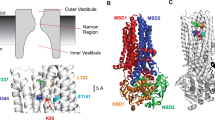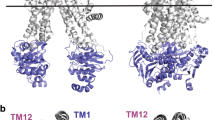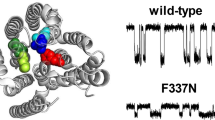Abstract
Chloride permeation through the cystic fibrosis transmembrane conductance regulator (CFTR) Cl− channel is subject to voltage-dependent open-channel block by a diverse range of cytoplasmic anions. However, in most cases the ability of these blocking substances to influence the pore opening and closing process has not been reported. In the present work, patch clamp recording was used to investigate the state-dependent block of CFTR by cytoplasmic Pt(NO2)4 2− ions. Two major effects of Pt(NO2)4 2− were identified. First, this anion caused fast, voltage-dependent block of open channels, leading to an apparent decrease in single-channel current amplitude. Secondly, Pt(NO2)4 2− also decreased channel open probability due to an increase in interburst closed times. Interestingly, mutations in the pore that weakened (K95Q) or strengthened (I344K, V345K) interactions with Pt(NO2)4 2− altered blocker effects both on Cl− permeation and on channel gating, suggesting that both these effects are a consequence of Pt(NO2)4 2− interaction with a single site within the pore. Experiments at reduced extracellular Cl− concentration hinted that Pt(NO2)4 2− may have a third effect, possibly increasing channel activity by interfering with channel closure. These results suggest that Pt(NO2)4 2− can enter from the cytoplasm into the pore inner vestibule of both open and closed CFTR channels, and that Pt(NO2)4 2− bound in the inner vestibule blocks Cl− permeation as well as interfering with channel opening and, perhaps, channel closure. Implications for the location of the channel gate in the pore, and the operation of this gate, are discussed.








Similar content being viewed by others
References
Bai Y, Li M, Hwang T-C (2010) Dual roles of the sixth transmembrane segment of the CFTR chloride channel in gating and permeation. J Gen Physiol 136:293–309
Bai Y, Li M, Hwang T-C (2011) Structural basis for the channel function of a degraded ABC transporter, CFTR (ABCC7). J Gen Physiol 138:495–507
Beck EJ, Yang Y, Yaemsiri S, Raghuram V (2008) Conformational changes in a pore-lining helix coupled to cystic fibrosis transmembrane conductance regulator channel gating. J Biol Chem 283:4957–4966
Cai Z, Sheppard DN (2002) Phloxine B interacts with the cystic fibrosis transmembrane conductance regulator at multiple sites to modulate channel activity. J Biol Chem 277:19546–19553
Csanády L, Töröcsik B (2014) Catalyst-like modulation of transition states for CFTR channel opening and closing: new stimulation strategy exploits nonequilibrium gating. J Gen Physiol 143:269–287
Dean M, Rzhetsky A, Allikmets R (2001) The human ATP-binding cassette (ABC) transporter superfamily. Genome Res 11:1156–1166
El Hiani Y, Linsdell P (2010) Changes in accessibility of cytoplasmic substances to the pore associated with activation of the cystic fibrosis transmembrane conductance regulator chloride channel. J Biol Chem 285:32126–32140
El Hiani Y, Linsdell P (2012) Tuning of CFTR chloride channel function by location of positive charges within the pore. Biophys J 103:1719–1726
Frizzell RA, Hanrahan JW (2013) Physiology of epithelial chloride and fluid secretion. Cold Spring Harb Perspect Med 3:a009498
Fuller MD, Thompson CH, Zhang Z-R, Freeman CS, Schay E, Szakács G, Bakos E, Sarkadi B, McMaster D, French RJ, Pohl J, Kubanek J, McCarty NA (2007) State-dependent inhibition of cystic fibrosis transmembrane conductance regulator chloride channels by a novel peptide toxin. J Biol Chem 282:37545–37555
Gong X, Linsdell P (2003) Mutation-induced blocker permeability and multiion block of the CFTR chloride channel pore. J Gen Physiol 122:673–687
Hunt JF, Wang C, Ford RC (2013) Cystic fibrosis transmembrane conductance regulator (ABCC7) structure. Cold Spring Harb Perspect Med 3:a009514
Hwang T-C, Kirk KL (2013) The CFTR ion channel: gating, regulation, and anion permeation. Cold Spring Harb Perspect Med 3:a009498
Jih K-Y, Hwang T-C (2012) Nonequilibrium gating of CFTR on an equilibrium theme. Physiology 27:351–361
Kirk KL, Wang W (2011) A unified view of cystic fibrosis transmembrane conductance regulator (CFTR) gating: combining the allosterism of a ligand-gated channel with the enzymatic activity of an ATP-binding cassette (ABC) transporter. J Biol Chem 286:12813–12819
Kopeikin Z, Sohma Y, Li M, Hwang T-C (2010) On the mechanism of CFTR inhibition by a thiazolidinone derivative. J Gen Physiol 136:659–671
Lansdell KA, Cai Z, Kidd JF, Sheppard DN (2000) Two mechanisms of genistein inhibition of cystic fibrosis transmembrane conductance regulator Cl− channels expressed in murine cell line. J Physiol 524:317–330
Linsdell P (2005) Location of a common inhibitor binding site in the cytoplasmic vestibule of the cystic fibrosis transmembrane conductance regulator chloride channel pore. J Biol Chem 280:8945–8950
Linsdell P (2014) Functional architecture of the CFTR chloride channel. Mol Membr Biol 31:1–16
Linsdell P (2014) Cystic fibrosis transmembrane conductance regulator chloride channel blockers: pharmacological, biophysical and physiological relevance. World J Biol Chem 26:26–39
Linsdell P, Gong X (2002) Multiple inhibitory effects of Au(CN)2 − ions on cystic fibrosis transmembrane conductance regulator Cl− channel currents. J Physiol 540:29–38
Lubamba B, Dhooghe B, Noel S, Leal T (2012) Cystic fibrosis: insight into CFTR pathophysiology and pharmacotherapy. Clin Biochem 45:1132–11144
Moran O, Galietta LJV, Zegarra-Moran O (2005) Binding site of activators of the cystic fibrosis transmembrane conductance regulator in the nucleotide binding domains. Cell Mol Life Sci 62:446–460
Seibert FS, Linsdell P, Loo TW, Hanrahan JW, Clarke DM, Riordan JR (1996) Disease-associated mutations in the fourth cytoplasmic loop of cystic fibrosis transmembrane conductance regulator compromise biosynthetic processing and chloride channel activity. J Biol Chem 271:15139–15145
Wang W, Linsdell P (2012) Conformational change opening the CFTR chloride channel pore coupled to ATP-dependent gating. Biochim Biophys Acta 1818:851–861
Wang W, Linsdell P (2012) Alternating access to the transmembrane domain of the ATP-binding cassette protein cystic fibrosis transmembrane conductance regulator (ABCC7). J Biol Chem 287:10156–10165
Wang W, Linsdell P (2012) Relative movements of transmembrane regions at the outer mouth of the cystic fibrosis transmembrane conductance regulator channel pore during channel gating. J Biol Chem 287:32136–32146
Wang W, El Hiani Y, Linsdell P (2011) Alignment of transmembrane regions in the cystic fibrosis transmembrane conductance regulator chloride channel pore. J Gen Physiol 138:165–178
Wang W, El Hiani Y, Rubaiy HN, Linsdell P (2014) Relative contribution of different transmembrane segments to the CFTR chloride channel pore. Pflugers Arch 466:477–490
Wang W, Li G, Clancy JP, Kirk KL (2005) Activating cystic fibrosis transmembrane conductance regulator channels with pore blocker analogs. J Biol Chem 280:23622–23630
Yeh JZ, Armstrong CM (1978) Immobilisation of gating charge by a substance that simulates inactivation. Nature 273:387–389
Zegarra-Moran O, Monteverde M, Galietta LJV, Moran O (2007) Functional analysis of mutations in the putative binding site for cystic fibrosis transmembrane conductance regulator potentiators. Interaction between activation and inhibition. J Biol Chem 282:9098–9104
Zhang Z-R, Song B, McCarty NA (2005) State-dependent chemical reactivity of an engineered cysteine reveals conformational changes in the outer vestibule of the cystic fibrosis transmembrane conductance regulator. J Biol Chem 280:41997–42003
Zhang Z-R, Zeltwanger S, McCarty NA (2000) Direct comparison of NPPB and DPC as probes of CFTR expressed in Xenopus oocytes. J Membr Biol 175:35–52
Zhou J-J, Fatehi M, Linsdell P (2007) Direct and indirect effects of mutations at the outer mouth of the cystic fibrosis transmembrane conductance regulator chloride channel pore. J Membr Biol 216:129–142
Zhou J-J, Li M-S, Qi J, Linsdell P (2010) Regulation of conductance by the number of fixed positive charges in the intracellular vestibule of the CFTR chloride channel pore. J Gen Physiol 135:229–245
Acknowledgements
I would like to thank Drs. Yassine El Hiani, Hussein Rubaiy, and Wuyang Wang for their assistance with this work. Supported by the Canadian Institutes of Health Research and Cystic Fibrosis Canada.
Author information
Authors and Affiliations
Corresponding author
Rights and permissions
About this article
Cite this article
Linsdell, P. State-dependent blocker interactions with the CFTR chloride channel: implications for gating the pore. Pflugers Arch - Eur J Physiol 466, 2243–2255 (2014). https://doi.org/10.1007/s00424-014-1501-7
Received:
Revised:
Accepted:
Published:
Issue Date:
DOI: https://doi.org/10.1007/s00424-014-1501-7




